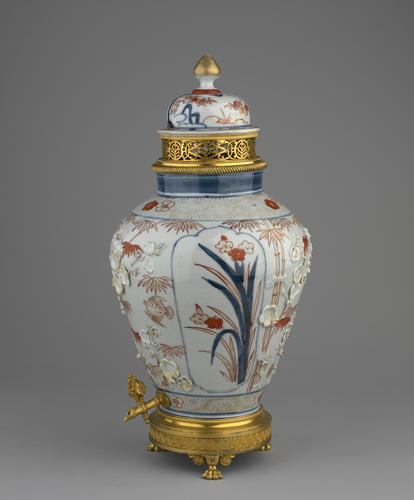-
1 of 253523 objects
Jar and cover Jar: 1690-1720, mounts:1780-1820
Porcelain with moulded relief decoration and painted in underglaze blue, overglaze enamel and gold, mounted in gilt bronze | 42.5 x 21.0 x 23.0 cm (whole object) | RCIN 39239

Japan
Jar and cover Jar: 1690-1720, mounts:1780-1820

Japan
Jar and cover Jar: 1690-1720, mounts:1780-1820


-
Three delicate plum blossom trees appear in applied relief on the body of this tall jar. In Japan, these five-petalled white flowers are admired for their ability to withstand the cold, and associated visually and poetically with snow. A poem by Ōtomo no Tabito (665–731) declares:
The flowers of the plum tree scatter in my garden – a shower of snow from the heavens!
The transition from winter to early spring is evoked by panels of narcissus, bamboo and plum blossom painted in red and gold overglaze enamels.
The jar has been mounted in Europe for use as an urn or, more likely, a pot-pourri. Fragrance from petals within would diffuse throughout the room through the pierced gilt-bronze band on the lid. Above the foot is a spigot modelled in imitation of bamboo, with a floral tap to release excess liquid from the wet pot-pourri inside. This new function reflects – perhaps unwittingly – the high status given to plum blossom’s scent in the Heian period (794 –1185). In the seasonal poems of the first imperial waka anthology, Kokin Wakashū (c.905), the blooms are praised for their powerful aroma.
George IV’s agent, François Benois, bought this jar in Paris on 6 December 1820 at a cost of 190 francs. It was evidently already mounted in gilt-bronze by this date, for it is described in the bill as a ‘fountain’ (‘1 fontaine du Japon Les fleurs en Relief’). It was soon after destined for the Royal Pavilion, Brighton, where it was displayed in the Large Lobby South by 1829.
An ovoid jar, with tapering sides and short neck, the domed cover with spreading rim and pointed gilt knob. The sides are decorated in applied relief with three white prunus trees, and, in between, upright pointed panels painted with narcissus among stems of bamboo and prunus in red and gold, with a plain band round the shoulder with several blooms, and a blue band round the neck. The cover is raised on a gilt-bronze milled rim above a pierced geometric openwork arcade of acanthus and palmettes, above a lower rim of a heavy rope-twist pattern; the foot is set in a spreading base with a rope-twist pattern band and guilloche ring, supported on three small claw feet. Above the foot, the vase is pierced on one side by a gilt-bronze spigot in the form of a section of bamboo, with floral tap.
Text adapted from Chinese and Japanese Works of Art in the Collection of Her Majesty The Queen: Volume II and Japan: Courts and Culture (2020)Provenance
Acquired by George IV, 1820. A bill for purchases dated 6 December 1820 includes ‘1 fontaine du Japon Les fleurs en Relief - 190 [francs]’ (Royal Archives GEO/MAIN/26440). Described in the Large Lobby South at the Royal Pavilion, Brighton, as ‘A Japan China Vase & Cover, with blue, red, & gold Trees, Birds & Flowers, and embossed flowers mounted with a pierced ormolu rim, & fir-apple top, Circular base, paw feet, & crane flower Tap, one foot four inches [40.6 cm]’ (1829B, p. 70); sent to Buckingham Palace in March 1847 (1829A, p. 27); later listed in the ‘1866’ Windsor Castle Inventory, pp. 412–13, no. 742, in the State Apartments Picture Gallery (now known as the Queen’s Drawing Room).
-
Creator(s)
(nationality)(metalworker)Acquirer(s)
-
Medium and techniques
Porcelain with moulded relief decoration and painted in underglaze blue, overglaze enamel and gold, mounted in gilt bronze
Measurements
42.5 x 21.0 x 23.0 cm (whole object)
Category
Object type(s)
Place of Production
Arita [Saga]